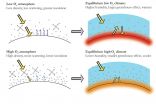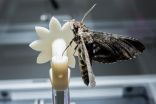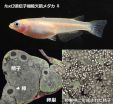Reactivating fault slip with fluid injection
2015-06-11
(Press-News.org) This news release is available in Japanese.
Water injected into an inactive fault can cause aseismic slip along the fault -- movement without detectable earthquakes -- that may then indirectly lead to micro-earthquakes. That's the result from a controlled experiment by Yves Guglielmi and colleagues, who observed these events in real time after injecting fluid into a natural fault near an underground experimental facility in southeastern France. Researchers are intensely interested in this type of induced seismicity, especially with a rise in earthquakes caused by injections of wastewater from gas and oil exploration. The experiment by Guglielmi and colleagues offers a better look at how friction in fluid-filled faults contributes to slip along the fault. In this case, the injected water caused very slow, four-micrometers-per-second aseismic creep on the fault before transitioning to a faster, 10-micrometers-per-second seismic slip and a series of tiny earthquakes. As Francois Cornet notes in a related Perspective article, experiments like this could guide monitoring at injection sites by potentially keeping the injection flow rate at a level that maintains aseismic slip rather than triggering earthquakes.
INFORMATION:
Article #17: "Seismicity triggered by fluid injection-induced aseismic slip," by Y. Guglielmi; P. Henry at University of Aix-Marseille in Aix-en-Provence, France; Y. Guglielmi; P. Henry at CNRS in Aix-en-Provence, France; Y. Guglielmi; P. Henry at Institut de recherche pour le développement (IRD) in Aix-en-Provence, France; F. Cappa at University of Nice Sophia-Antipolis in Sophia-Antipolis, France; F. Cappa at CNRS in Sophia-Antipolis, France; F. Cappa at Institut de recherche pour le développement (IRD) in Sophia-Antipolis, France; F. Cappa at Côte d'Azur Observatory in Sophia-Antipolis, France; F. Cappa; J.-P. Avouac at California Institute of Technology in Pasadena, CA; D. Elsworth at Pennsylvania State University in University Park, PA; J.-P. Avouac at University of Cambridge in Cambridge, UK.
ELSE PRESS RELEASES FROM THIS DATE:
2015-06-11
This news release is available in Japanese. New experiments in the Japanese rice fish show that the fox13 gene appears to be the switch that determines whether a germ cell becomes an egg or sperm cell. The finding could help researchers learn more about how the sexual fate of germ cells is determined during vertebrate development. Toshiya Nishimura and colleagues demonstrated that fox13, which is expressed in germ cells but not in the surrounding cells of the fish's reproductive organs, provides a molecular cue that prevents the start of sperm formation. When the researchers ...
2015-06-11
This news release is available in Japanese.
Variations in the percentage of atmospheric oxygen may have influenced climate in the past 500 million years, according to new calculations by Christopher Poulsen and colleagues. Since oxygen isn't a greenhouse gas like carbon dioxide, it typically hasn't been included in studies of past climate change. But the proportion of atmospheric oxygen has varied between 10 percent and 35 percent over the past 500 million years, and Poulsen and colleagues have developed a model to show how those fluctuations might impact climate. ...
2015-06-11
This news release is available in Japanese.
How do nocturnal insects forage so successfully in the twilight and darkness? A new study by Simon Sponberg and colleagues suggests that the vision of the hawkmoth, Manduca sexta, which hovers in place while it feeds on nectar at dawn and dusk, is finely attuned to the swaying of flowers in the breeze. These findings imply that both the sight and flight of the hawkmoth likely evolved to match the movements of flowers -- their only source of food -- perfectly, helping to explain how the nimble insects are able ...
2015-06-11
A new study by researchers at the Stanford University School of Medicine found that synchronized physiological interactions between remote brain regions have genetic underpinnings.
The research was performed at Stanford but was made possible by collaborations with the Seattle-based Allen Institute for Brain Science and the IMAGEN Consortium, a multicenter European project, said the study's senior author, Michael Greicius, M.D., an associate professor of neurology and neurological sciences.
The study will be published June 11 in Science.
An emerging consensus among ...
2015-06-11
This news release is available in German.
It has been hypothesized that globalization of human-mediated dispersal of species may break down biogeographic boundaries. However, empirical tests had been lacking until recently. An international research team has now discovered a comprehensive biogeographic reorganization for 175 species of alien gastropods across 56 countries. The data shows that homogenization is indeed happening. Geographic barriers to dispersal have fallen down but climate still limits how species colonize new areas. The study was published in the ...
2015-06-11
Investigators from Massachusetts General Hospital (MGH) and the Ragon Institute of MGH, MIT and Harvard have added another piece to the puzzle of how a small group of individuals known as elite controllers are able to control HIV infection without drug treatment. In their paper published in the open-access journal PLOS Pathogens, the research team reports finding that dendritic cells of elite controllers are better able to detect the presence of HIV - paradoxically through a greater susceptibility to HIV infection - which enables them to stimulate the generation of T cells ...
2015-06-11
The concept sounds like the stuff of science fiction: take a pill, and suddenly new tissues grow to replace damaged ones.
Researchers at Case Western Reserve and UT Southwestern Medical Center this week announced that they have taken significant steps toward turning this once-improbable idea into a vivid reality. In a study published in the June 12 edition of Science, they detail how a new drug repaired damage to the colon, liver and bone marrow in animal models -- even going so far as to save the lives of mice who otherwise would have died in a bone marrow transplantation ...
2015-06-11
This news release is available in Japanese.
Researchers in Japan have found, for the first time in vertebrates, a genetic switch that determines whether germ cells become sperm or eggs. The gene is named foxl3, and has been identified using a small fish called medaka (Oryzias latipes). In medaka without this gene's functionality, surprisingly, sperm are produced in the ovaries of females. The sperm that are produced function normally, and have been confirmed to produce normal offspring. These results will be announced in the journal Science through Science Express ...
2015-06-11
EDMONTON, Canada, June 11 -- In this summer's much anticipated blockbuster Jurassic World, actor Chris Pratt joins forces with a pack of swift and lethal velociraptors. 'Velociraptor belongs to a group of predatory dinosaurs called the deinonychosaurs, or simply the 'raptors',' says University of Alberta paleontologist Scott Persons. 'Raptors are characterized by particularly nasty feet. Their big toes each bore an enlarged and wickedly hooked talon, which makes raptors well suited for Hollywood fight scenes.'
Persons and University of Alberta alumnus Lida Xing are part ...
2015-06-11
A NASA mission led by UCLA professor Christopher Russell has released new images of the dwarf planet Ceres, the largest asteroid between Mars and Jupiter.
The photos were produced by the spacecraft Dawn, which is now observing Ceres from 2,700 miles above its surface; NASA has also produced a one-minute video animation that sheds new light on this mysterious and heavily cratered world.
'Everything we learn from Ceres will be absolutely new,' said Christopher Russell, a UCLA professor of space physics and planetary science, and the Dawn mission's principal investigator. ...
LAST 30 PRESS RELEASES:
[Press-News.org] Reactivating fault slip with fluid injection


